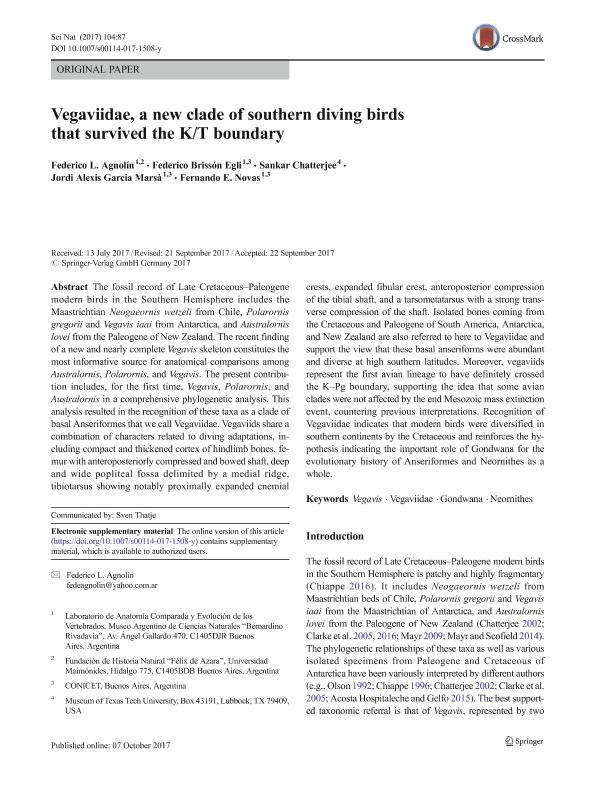Mostrar el registro sencillo del ítem
dc.contributor.author
Agnolin, Federico

dc.contributor.author
Brissón Egli, Federico

dc.contributor.author
Chatterjee, Sankar
dc.contributor.author
García Marsa, Jordi Alexis

dc.contributor.author
Novas, Fernando Emilio

dc.date.available
2018-06-29T17:40:47Z
dc.date.issued
2017-10
dc.identifier.citation
Agnolin, Federico; Brissón Egli, Federico; Chatterjee, Sankar; García Marsa, Jordi Alexis; Novas, Fernando Emilio; Vegaviidae, a new clade of southern diving birds that survived the K/T boundary; Springer; Naturwissenschaften; 104; 87; 10-2017; 1-9
dc.identifier.issn
0028-1042
dc.identifier.uri
http://hdl.handle.net/11336/50697
dc.description.abstract
The fossil record of Late Cretaceous-Paleogene modern birds in the Southern Hemisphere includes the Maastrichtian Neogaeornis wetzeli from Chile, Polarornis gregorii and Vegavis iaai from Antarctica, and Australornis lovei from the Paleogene of New Zealand. The recent finding of a new and nearly complete Vegavis skeleton constitutes the most informative source for anatomical comparisons among Australornis, Polarornis, and Vegavis. The present contribution includes, for the first time, Vegavis, Polarornis, and Australornis in a comprehensive phylogenetic analysis. This analysis resulted in the recognition of these taxa as a clade of basal Anseriformes that we call Vegaviidae. Vegaviids share a combination of characters related to diving adaptations, including compact and thickened cortex of hindlimb bones, femur with anteroposteriorly compressed and bowed shaft, deep and wide popliteal fossa delimited by a medial ridge, tibiotarsus showing notably proximally expanded cnemial crests, expanded fibular crest, anteroposterior compression of the tibial shaft, and a tarsometatarsus with a strong transverse compression of the shaft. Isolated bones coming from the Cretaceous and Paleogene of South America, Antarctica, and New Zealand are also referred to here to Vegaviidae and support the view that these basal anseriforms were abundant and diverse at high southern latitudes. Moreover, vegaviids represent the first avian lineage to have definitely crossed the K-Pg boundary, supporting the idea that some avian clades were not affected by the end Mesozoic mass extinction event, countering previous interpretations. Recognition of Vegaviidae indicates that modern birds were diversified in southern continents by the Cretaceous and reinforces the hypothesis indicating the important role of Gondwana for the evolutionary history of Anseriformes and Neornithes as a whole.
dc.format
application/pdf
dc.language.iso
eng
dc.publisher
Springer

dc.rights
info:eu-repo/semantics/openAccess
dc.rights.uri
https://creativecommons.org/licenses/by-nc-sa/2.5/ar/
dc.subject
Gondwana
dc.subject
Neornithes
dc.subject
Vegaviidae
dc.subject
Vegavis
dc.subject.classification
Meteorología y Ciencias Atmosféricas

dc.subject.classification
Ciencias de la Tierra y relacionadas con el Medio Ambiente

dc.subject.classification
CIENCIAS NATURALES Y EXACTAS

dc.title
Vegaviidae, a new clade of southern diving birds that survived the K/T boundary
dc.type
info:eu-repo/semantics/article
dc.type
info:ar-repo/semantics/artículo
dc.type
info:eu-repo/semantics/publishedVersion
dc.date.updated
2018-06-19T16:01:00Z
dc.identifier.eissn
1432-1904
dc.journal.volume
104
dc.journal.number
87
dc.journal.pagination
1-9
dc.journal.pais
Alemania

dc.journal.ciudad
Berlin
dc.description.fil
Fil: Agnolin, Federico. Consejo Nacional de Investigaciones Científicas y Técnicas. Oficina de Coordinación Administrativa Parque Centenario. Museo Argentino de Ciencias Naturales “Bernardino Rivadavia”; Argentina. Fundación de Historia Natural Félix de Azara; Argentina
dc.description.fil
Fil: Brissón Egli, Federico. Consejo Nacional de Investigaciones Científicas y Técnicas. Oficina de Coordinación Administrativa Parque Centenario. Museo Argentino de Ciencias Naturales “Bernardino Rivadavia”; Argentina
dc.description.fil
Fil: Chatterjee, Sankar. Museum Of Texas Tech University; Estados Unidos
dc.description.fil
Fil: García Marsa, Jordi Alexis. Consejo Nacional de Investigaciones Científicas y Técnicas. Oficina de Coordinación Administrativa Parque Centenario. Museo Argentino de Ciencias Naturales “Bernardino Rivadavia”; Argentina
dc.description.fil
Fil: Novas, Fernando Emilio. Consejo Nacional de Investigaciones Científicas y Técnicas. Oficina de Coordinación Administrativa Parque Centenario. Museo Argentino de Ciencias Naturales “Bernardino Rivadavia”; Argentina
dc.journal.title
Naturwissenschaften

dc.relation.alternativeid
info:eu-repo/semantics/altIdentifier/url/https://link.springer.com/article/10.1007%2Fs00114-017-1508-y
dc.relation.alternativeid
info:eu-repo/semantics/altIdentifier/doi/http://dx.doi.org/10.1007/s00114-017-1508-y
Archivos asociados
